Tolumnia orchid
Last reviewed: 11.03.2025
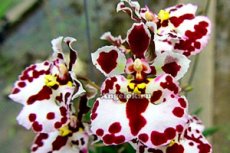
The Tolumnia orchid is a miniature plant from the Orchidaceae family, known for its compact size and abundant flowering. The genus Tolumnia includes about 30 species and numerous hybrids, prized for their bright, butterfly-like flowers. These orchids are popular among plant enthusiasts for their decorative qualities, diverse forms, and relative ease of care.
Etymology of the name
The genus name Tolumnia is derived from ancient Greek, possibly referencing mythological characters. Initially, these plants were classified under the genus Oncidium, but in 1986, Tolumnia was established as a separate genus based on specific morphological distinctions.
Life form
Tolumnia is an epiphytic plant, meaning it grows on trees in its natural habitat, attaching to bark with aerial roots. This adaptation allows it to absorb moisture and nutrients from the environment, including rainwater and organic material on the tree's surface.
This life form makes Tolumnia highly resistant to short periods of drought, a vital trait in its native tropical forests of the Caribbean. In indoor cultivation, its roots require special care to maintain their ability to absorb moisture effectively.
Family
Tolumnia belongs to the Orchidaceae family, one of the largest and most diverse families of flowering plants, with over 28,000 species. Members of this family are known for their complex flowers and unique pollination mechanisms.
A notable feature of this family is the symbiotic relationship with mycorrhizal fungi, essential for successful seed germination. Like other orchids, Tolumnia demonstrates adaptability to various ecological conditions.
Botanical characteristics
Tolumnia is a miniature plant reaching 10–15 cm in height. Its leaves are narrow, linear, and dense, forming rosettes. Flowers, about 2–3 cm in diameter, are borne on slender flower spikes that can grow up to 50 cm long. Blooming is usually profuse, with 10–15 flowers on a single spike.
The aerial roots are covered with velamen, enabling the plant to efficiently absorb moisture from the air. The flowers come in vibrant shades of red, yellow, white, or purple, often with spots or patterns.
Chemical composition
The chemical composition of Tolumnia includes anthocyanins responsible for the bright coloration of the flowers, as well as polysaccharides and organic acids that provide protection against pathogens and environmental stress.
Origin
Tolumnia originates from the Caribbean, including islands such as Cuba, Jamaica, Haiti, and the Dominican Republic. Its natural habitat consists of humid tropical forests, where the plants grow on trees under conditions of high humidity.
The cultivation of Tolumnia began due to its decorative qualities. Today, it is grown worldwide as a houseplant, especially in regions with mild climates.
Ease of cultivation
Tolumnia is considered a relatively easy orchid to care for if its basic needs are met. It prefers bright, diffused light, high air humidity, and an appropriate watering regime.
For successful cultivation, it is essential to use a suitable substrate that provides quick drainage and good aeration. Tolumnia is often grown in hanging baskets or mounted on blocks to ensure adequate airflow around the roots.
Species and varieties
The most well-known species of Tolumnia include Tolumnia guianensis,
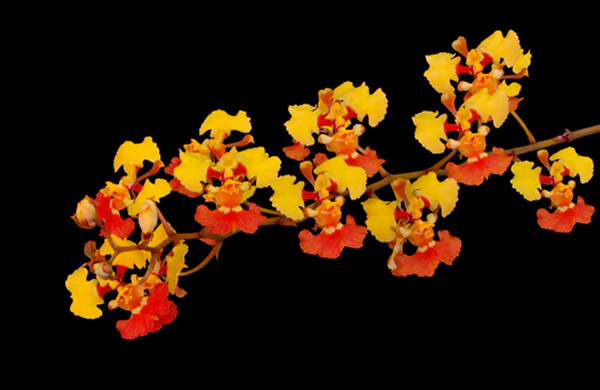
Tolumnia variegata, and
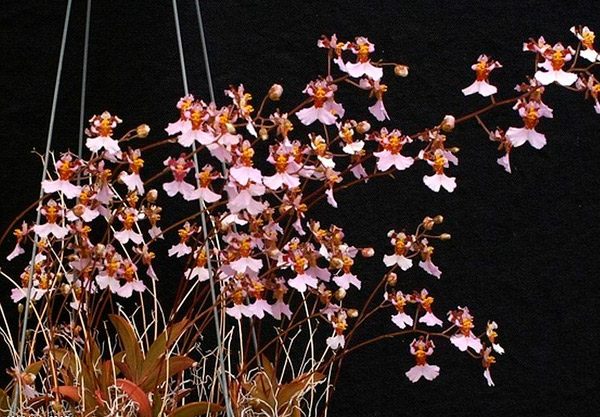
Tolumnia bahamensis.
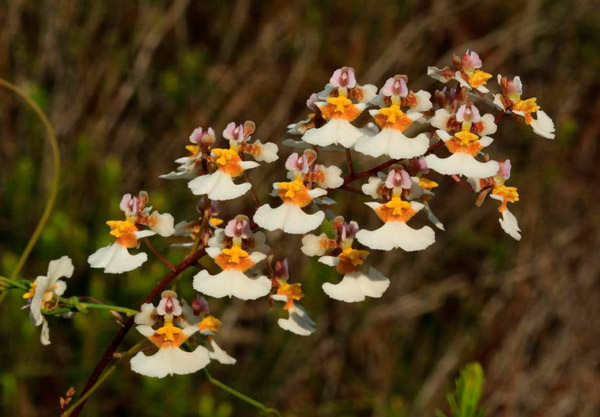
Popular hybrids such as Tolumnia Jairak Flyer and
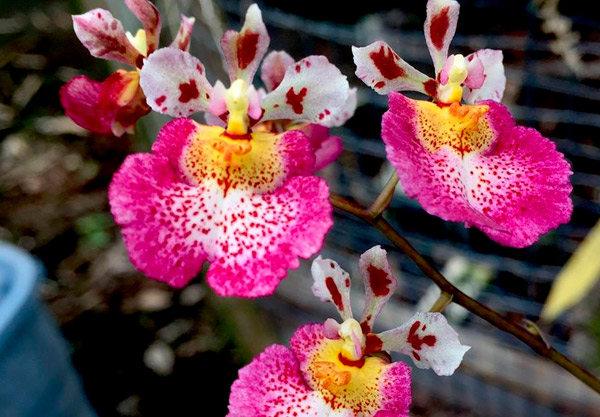
Tolumnia Pink Panther are notable for their bright and unusual flower colors.
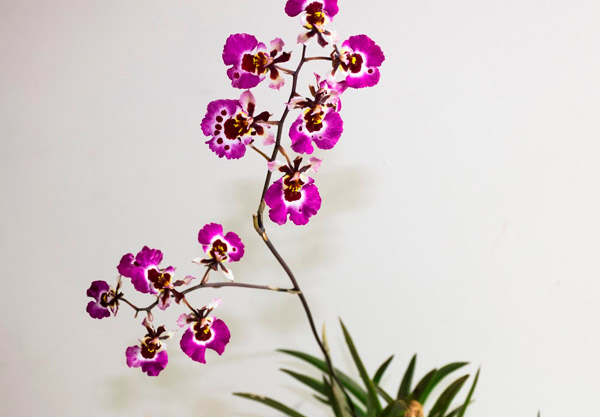
Size
Tolumnia is a miniature plant, rarely exceeding 15 cm in height, making it suitable for even small spaces. In contrast, its flower spikes can grow up to 50 cm long, giving the plant an elegant appearance.
The flowers, typically 2–3 cm in diameter, appear relatively large for such a compact plant, making Tolumnia a striking accent in indoor arrangements.
Growth rate
Tolumnia has a moderate growth rate. It typically produces 1–2 new rosettes annually, which can bloom once they mature.
Optimal conditions, such as good lighting and regular care, can promote faster development. However, overwatering should be avoided, as it can slow growth or damage the plant.
Lifespan
Tolumnia is a long-lived plant. With proper care, it can thrive and bloom for decades. Regular rejuvenation, achieved by dividing rosettes, extends its lifespan and keeps the plant healthy.
In natural conditions, its lifespan may be shorter due to competition and environmental challenges. However, in cultivation, it demonstrates remarkable resilience.
Temperature
Tolumnia thrives in moderate temperatures ranging from 18–28 °C. It can tolerate brief temperature increases if sufficient humidity is maintained.
Nighttime temperature drops (5–7 °C lower than daytime) stimulate flowering, an important factor for indoor cultivation.
Humidity
Tolumnia requires air humidity levels of 50–70%. In drier conditions, regular misting of the roots is essential, especially on hot days.
Excessive moisture can lead to root rot, so maintaining a balance between humidity and ventilation is crucial.
Lighting and placement in a room
Tolumnia needs bright, diffused light but should be protected from direct sunlight, which can cause leaf burns. The ideal location is an east- or west-facing window with midday shading.
Placing the plant in hanging baskets or on mounts ensures adequate airflow for the roots. When grown in pots, transparent containers are recommended to monitor root health.
Soil and substrate
For successful cultivation of Tolumnia orchids, it is recommended to use a specialized substrate that provides excellent drainage and aeration. The optimal mix includes:
- Coarse pine bark (60%);
- Sphagnum moss (20%);
- Perlite or small pumice stones (10%);
- Charcoal (10%).
The recommended pH level of the substrate is 5.5–6.5, corresponding to a slightly acidic environment. To prevent waterlogging, ensure proper drainage by placing a 2–3 cm layer of expanded clay or gravel at the bottom of the pot.
Watering
During the summer, Tolumnia requires thorough but infrequent watering. It is advisable to submerge the roots completely in soft, slightly warm water for 10–15 minutes, allowing excess water to drain afterward. Watering is typically done once every 5–7 days, depending on temperature and humidity.
In winter, the watering frequency should be reduced to once every 10–14 days to avoid overwatering the substrate. Use room-temperature, dechlorinated water. Allow the roots to dry slightly between waterings to prevent rot.
Fertilization and feeding
Water-soluble fertilizers designed for orchids, with a low nitrogen concentration, are ideal for Tolumnia. It is crucial to choose products enriched with essential micronutrients, including magnesium, iron, and calcium.
Fertilizers should be diluted in water at 1/4 of the recommended strength and applied during watering. Feed the plant every two weeks during its active growth and flowering periods. In winter, reduce feeding to once a month or suspend it entirely.
Propagation
The best time to propagate Tolumnia is in spring or early summer when the plant is actively growing. Propagation should ideally be done before the flowering phase.
The most common propagation method is dividing mature plants by separating rosettes with 3–4 leaves and roots. Seed propagation is less common, as it requires sterile conditions and a symbiotic relationship with mycorrhizal fungi for germination.
Flowering
Tolumnia produces abundant flowers on spikes up to 50 cm long, with each spike bearing up to 15 vibrant blooms. The flowering period lasts 4 to 6 weeks, depending on growing conditions.
After flowering, flower spikes can remain for potential reblooming. However, if the plant does not recover well, the spike should be cut off at its base.
Seasonal features
During spring and summer, Tolumnia requires more frequent watering and regular fertilization, as this is its active growth and flowering period. In winter, the plant enters dormancy, requiring reduced watering and cooler temperatures.
In autumn, gradually reduce watering to prepare the plant for winter rest. This practice helps prevent stress and maintains healthy roots.
Care specifics
Tolumnia is sensitive to water quality. Use soft, filtered, or rainwater whenever possible. To maintain optimal air humidity (50–70%), consider using a humidifier or placing a water tray near the plant.
Proper ventilation is crucial to prevent rot and pest infestations. However, avoid drafts, as they may damage the leaves.
Indoor care
To grow Tolumnia indoors, choose a brightly lit location away from direct sunlight. East- or west-facing windows with midday shading are ideal.
Pots or baskets should be transparent to allow monitoring of root health. If grown on mounts, ensure sufficient humidity and frequent misting of the roots.
Repotting
For Tolumnia, small plastic or ceramic pots with multiple drainage holes are ideal. The pot size should fit the root system snugly.
Repotting is recommended every 2–3 years or when the substrate begins to break down. The best time to repot is in spring, before the plant enters active growth.
Pruning and shaping
Tolumnia does not require traditional pruning. However, spent flower spikes should be removed if no new buds are forming. Damaged or diseased leaves can also be trimmed to maintain the plant's health.
Remove old or dried roots to promote new growth and keep the plant visually appealing.
Common problems and solutions
Tolumnia is prone to fungal diseases caused by overwatering. Preventive measures include moderate watering and ensuring proper ventilation.
Insufficient light causes leaf elongation and lack of flowering. Yellowing leaves may indicate sunburn or overwatering.
Pests
Common pests affecting Tolumnia include spider mites, scale insects, and thrips. Use insecticides, such as pyrethroid-based products, to control infestations.
Regular misting and maintaining high humidity can help prevent pest problems.
Air purification
Like many orchids, Tolumnia contributes to air purification by removing harmful substances such as formaldehyde and benzene. This makes it a valuable addition to urban interiors.
Safety
Tolumnia is a non-toxic plant, making it safe for children and pets. However, individual allergic reactions to pollen or plant sap are possible.
Winter care
During winter dormancy, reduce watering to once every 10–14 days and lower the temperature to 16–18 °C. These conditions help the plant prepare for spring growth and flowering.
Beneficial properties
In addition to its decorative appeal, Tolumnia enhances indoor air quality by increasing humidity and reducing airborne pollutants.
Use in traditional medicine
While Tolumnia is not widely used in traditional medicine, it is occasionally incorporated into decorative arrangements with medicinal plants in folk remedies.
Use in landscape design
Tolumnia is ideal for creating vertical gardens and hanging arrangements. Its compact size and vibrant flowers make it a popular choice for decorating terraces and balconies.
Compatibility with other plants
Tolumnia pairs well with other epiphytic plants, such as Phalaenopsis and Oncidiums. Its compact size allows it to coexist with larger species without taking up excessive space.
Conclusion
Tolumnia is a unique orchid that combines decorative beauty, low maintenance, and environmental benefits. With proper care, it can become a stunning centerpiece in any home or garden, bringing joy to its owners for many years.
